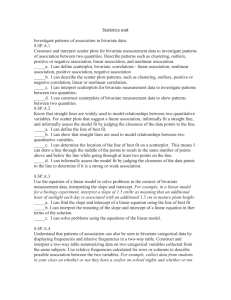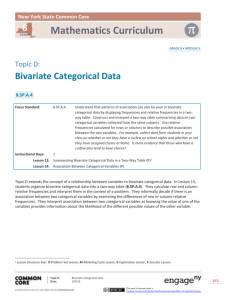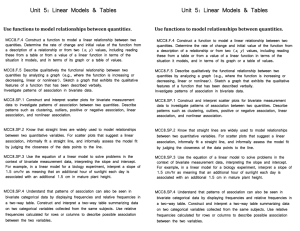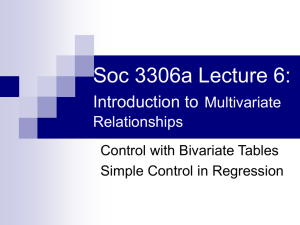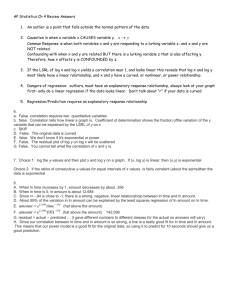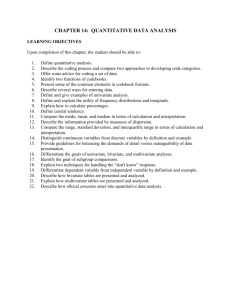Chapter 4 - StatsMonkey.
advertisement
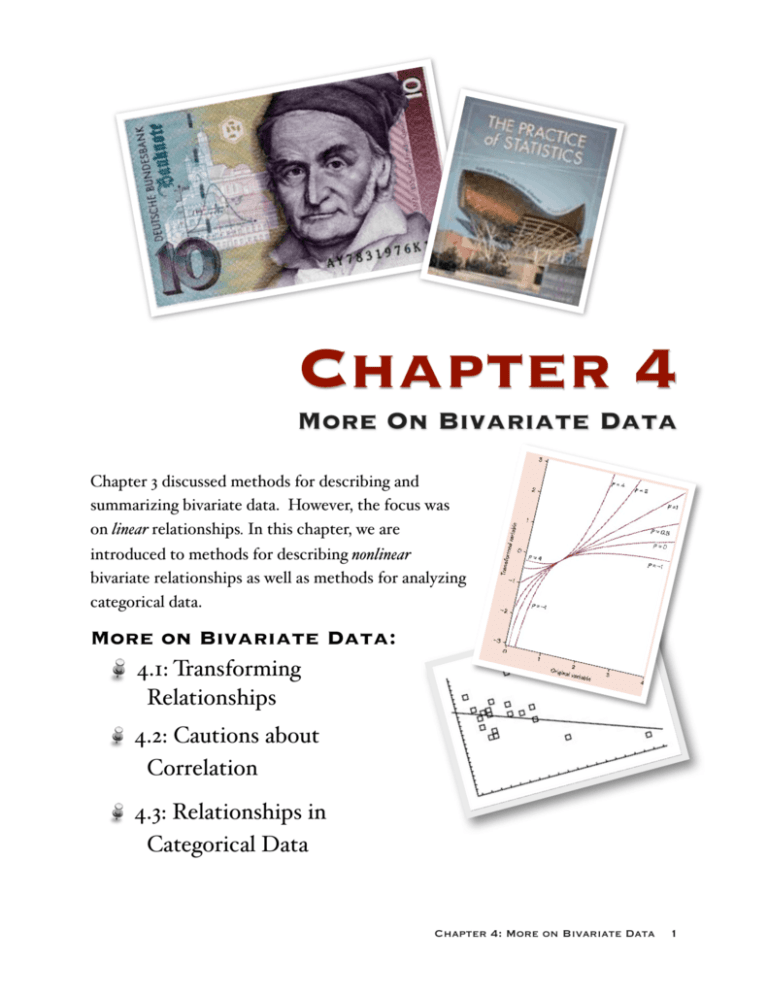
Chapter 4
More On Bivariate Data
Chapter 3 discussed methods for describing and
summarizing bivariate data. However, the focus was
on linear relationships. In this chapter, we are
introduced to methods for describing nonlinear
bivariate relationships as well as methods for analyzing
categorical data.
More on Bivariate Data:
4.1: Transforming
Relationships
4.2: Cautions about
Correlation
4.3: Relationships in
Categorical Data
Chapter 4: More on Bivariate Data
1
AP STATS CHAPTER 4:
MORE ON BIVARIATE DATA
"NUMBERS ARE LIKE PEOPLE...TORTURE THEM LONG ENOUGH AND THEY’LL
TELL YOU ANYTHING...”
Tentative Lesson Guide
Date
Mon
10/23
Tues
10/24
Wed
10/25
Thu
10/26
Fri
10/27
Mon
Tues
Wed
Thu
Fri
10/30
10/31
11/1
11/2
11/3
Mon
Tues
11/6
11/7
Stats
4.1
4.1
4.1
Rev
Quiz
4.2
4.2
4.2
4.3
4.3
Lesson
Transforming Relationships
Power and Exponential Models
Modeling Nonlinear Data
Review 4.1
Quiz 4.1
Cautions about Correlation
The Question of Causation
Causation Practice
Categorical Relationships
Simpson’s Paradox
Review
Exam Exam Chapter 4
Rev
Note:
The purpose of this guide is to help you organize your studies for this chapter.
The schedule and assignments may change
slightly.
Assignment
Done
Rd 192-205 Do 3-5
Rd 214-219 Do 13-16
Nonlinear Modeling Practice
Rd 149-156 Do 38-41
Rd 157-165 Do 42-43, 45
!
Rd 225-230 Do 27-31
Rd 231-237 Do 33-37
Rd 238 Do 38-49
Rd 241-245 Do 53-55
Rd 246-250 Do 59-61
Do 72-73, 81-83
Online Quiz Due
Class Website:
Be sure to log on to the class website for
notes, worksheets, links to our text companion site, etc.
http://web.mac.com/statsmonkey
Keep your homework organized and refer to
this when you turn in
your assignments at
the end of the chapter.
Don’t forget to take your online quiz!. Be
sure to enter my email address correctly!
http://bcs.whfreeman.com/yates2e
My email address is:
jmmolesky@isd194.k12.mn.us
Chapter 4: More on Bivariate Data 2
Chapter 4 Objectives and Skills:
These are the expectations for this chapter. You should be able to answer these questions and perform
these tasks accurately and thoroughly. Although this is not an exhaustive review sheet, it gives a good
idea of the "big picture" skills that you should have after completing this chapter. The more thoroughly
and accurately you can complete these tasks, the better your preparation.
Transforming Data:
If a scatterplot shows a curved pattern, it can perhaps be conveniently modeled by an exponential growth or
decay function of the form y = ab^x or a power function of the form y = ax^b. In these situations, we can linearize the data by making use of logarithms.
If a scatterplot suggests an exponential or power function, we should check to see which model is appropriate
by transforming x, y, or both variables and checking the linearity of the resulting scatterplot. If (x, logy) appears
linear, an exponential model may work best. If (logx, logy) appears linear, we may want to try a power model. Find
the LSRL for the transformed data and then perform the reverse transformation to find the regression model.
Know how to transform back to a power/exponential model
CAUTIONS ABOUT CAUSATION:
Correlation and regression need to be interpreted with caution. Two variables may be strongly associated, but
this does not mean that one causes the other. Bottom line: High correlation does not imply causation. Among
other things, lurking variables and common response should always be considered:
• Extrapolation: Using LSRL to predict values outside the domain of the explanatory variable used to create the
line. (It is generally best to avoid extrapolating.)
• Lurking variable: A variable that effects the relationship of the variables in a study, but is not included among the
variables studied.
• Correlation based on averages are frequently higher than correlation based on all of the numbers that make up
the averages.
If there is a strong association between two variables x and y, any one of the following statements could be true.
• x causes y
• both x and y are responding to changes in some unobserved variable or variables.
• the effect of x on y is hopelessly mixed up with the effects of other variables on y. Because of this, it is impossible to directly determine the effects of x on y.
RELATIONSHIPS IN CATEGORICAL DATA:
A two-way table of counts describes the relationship between two categorical variables... the row variable and
the column variable. The row totals and column totals give the marginal distributions of the two variables separately, but do not give any information about the relationships between the variables. Probabilities, including conditional probabilities, can be calculated from two-way tables.
In some cases, lurking variables can cause a reversal in the direction of a comparison or association when data
from several groups are combined to form a single group. This phenomenon is called "Simpson's Paradox."
Mmmmmmmmm...
Chapter 4: More on Bivariate Data 3
4.1: Introduction to Nonlinear Relationships
Data that displays a curved pattern can be modeled by a number of different functions. Two of the most
common nonlinear models are exponential (y=ABx) and power (y=AxB). We will focus on these two
models in this chapter. Our goal is to fit a model to curved data so that we can make predictions as we
did in Chapter 3. However, the only statistical tool we have to fit a model is the least-squares regression
model. Therefore, in order to find a model for curved data, we must first “straighten it out”…
Mmmmmm…Theory.
• Consider an Exponential Model"
y= A Bx#
#
#
• Take the log of both sides"
"
"
#
"
"
#
"
• Consider a Power Model
#
y= A xB
• Take the log of both sides
Conclusion:
If data is exponential in nature, the graph of (x , log y) will be linear.
If data has a power relationship, the graph of (logx , logy) will be linear.
In order to make predictions with our model, we need to convert the LSRL of the transformed data
back to the original terms of the problem. We can do this by using inverse functions…
Predicting with an Exponential Model! !
Predicting with a Power Model
LSRL of transformed data:
Exponential Model:#
#
##
#
#
LSRL of transformed data:
#
#
#
Power Model:
So, in a nutshell, to find an Exponential or Power Model:
1)
2)
3)
4)
Chapter 4: More on Bivariate Data 4
“Moleskium” Decay Activity
The decay of radioactive isotopes typically creates a nonlinear relationship between time and amount
remaining. “Moleskium” is a little-known element found in a short, highly caffeinated math teacher at
LSHS. Without proper caffeination, “Moleskium” can decay quite rapidly...trust me, it’s not a pretty site
when that happens.
"
We will be simulating the decay of “Moleskium” through the use of Skittles® bite-sized candies.
{Actually depriving Mr.M. of caffeine to observe the real-life decay of “Moleskium” would be unethical, so
we’ll rely on Skittles to simulate the phenomenon.} As we proceed through this simulation, be sure to
dispose of the “decayed” Skittles in a nearby oral cavity or waste-disposal container.
Disclaimer: DO NOT eat actual radioactive isotopes. These are pretend so it’s ok.
“Moleskium” Decay Simulation:
Start with a sizeable (n>60) quantity of Skittles in a covered container.
Shake the container to simulate typical Mr.M. activity.
Open the container and remove all Skittles that have “decayed” {ie, no “S” showing}
Count the remaining Skittles and record in the table below.
Repeat until all Skittles have “decayed”.
Round
Number
0
Isotopes
Remaining
Enter the “Round” into L1 and “Isotopes” into L2.
Display the relationship with a scatterplot and interpret in context:
1
2
3
4
5
6
7
8
9
Use your calculator to find the LSRL for (round, isotopes):
LSRL:________________________________________
10
11
Sketch the residual plot for this LSRL and use it to discuss the appropriateness of using a linear model for this relationship.
12
Chapter 4: More on Bivariate Data 5
“Moleskium” Decay Activity - Continued
We can tell by the scatterplot of (round, isotopes) and by the residual plot of (round, residual) that a
nonlinear model may be a more appropriate model for this situation. However, the question that remains is, “Which model is more appropriate? Exponential or Power?” Our eyes are fairly good at judging whether or not points lie on a straight line. However, they are not very good at spotting the difference between power and exponential curves. Therefore, we’ll use the fact that certain transformations
of power and exponential data produce linear relationships. If we can determine which transformation
does a better job of “straightening out the data” then we’ll have a better idea which model is best.
Use your list editor to define L3 = log(round) and L4 = log(isotopes).
Remember, if (x, logy) is linear, an exponential model may be best. If (logx, logy) is linear, a power
model may be best. All we have to do is plot the two and determine which is “more linear”.
Sketch (x, logy) and interpret
Sketch (logx, logy) and interpret
Find the LSRL for the transformed data that exhibits the most linear relationship. Justify “most linear”
by considering the correlation and residual plots for each set of transformed data.
Since the LSRL is written in terms of transformed data, transform it back into the original terms of
the problem. That is, find a prediction model that will convert “round number” into “isotopes remaining”.
Final Prediction Model for “Moleskium” Decay:__________________________________
Chapter 4: More on Bivariate Data 6
4.1: Nonlinear Transformation Practice
1. Do aircraft with a higher typical speed also have greater average flight lengths? Use the following data
to create a model that predicts the average flight length (miles) for a plane based on its typical speed
(mph). Show all scatterplots, residual plots, and analyses used to determine your model.
mph
518
539
529
498
513
498
504
516
467
524
523
495
464
486
mi
2882
5063
3321
1363
2451
1493
1963
2379
1126
3253
2995
2331
1167
2135
mph
441
440
458
414
432
416
374
388
412
387
389
384
380
mi
782
742
1101
702
798
602
345
442
570
487
468
500
413
Use your model to predict an average flight length for a plane that typically flies at a speed of 525mph.
2. The following data describe the number of police officers (thousands) and the violent crime rate (per
100,00 population) in a sample of states. Use these data to determine a model for predicting violent
crime rate based on number of police officers employed. Show all appropriate plots and work.
Police
86.2
9.2
45
39.9
6
11.8
2.9
14.6
30.5
12.3
46.2
15.2
10.9
Crime
1090
559
1184
1039
303
951
132
763
635
726
840
373
523
Use your model to predict the violent crime rate for a state with 25,400 police officers.
3. Consider the following data on population density of the United States (Statistical Abstract of the
United States, 1996). Find a prediction model for population density based on year. Show all work.
Year
Density
Year
Density
Year
Density
Year
Density
Year
Density
1800
6.1
1840
9.8
1880
16.9
1920
35.6
1960
50.6
1810
4.3
1850
7.9
1890
21.2
1930
41.2
1970
57.4
1820
5.5
1860
10.6
1900
25.6
1940
44.2
1980
64.0
1830
7.4
1870
13.4
1910
31.0
1950
50.7
1990
70.3
Use your model to predict the population density in 2006.
Chapter 4: More on Bivariate Data 7
Modeling NonLinear Data
Plot !x,y"
Interpret Strength, Direction, Form
Chapter 4: More on Bivariate Data 8
The Question of Causation
When building prediction models for bivariate data, you should always start with a plot of your explanatory vs. response variables. Analysis of the residual plots and correlation coefficient can help you assess
the appropriateness of your model for prediction. However, you should always use caution when interpreting exactly what the cause of the relationship between two variables is.
Consider the following historical data. Construct a prediction model based on the data and discuss the
strength of the observed relationship. We will discuss what x and y are after we build the model:
Year
x=?
y=?
1860
63
8376
1865
48
6406
1870
53
7005
1875
64
8486
1880
72
9595
1885
80
10643
1890
85
11265
1895
76
10071
Correlation Coefficient r=_______________________
1900
80
10547
What does the correlation imply about the relationship?
1905
83
11008
1910
105
13885
1915
140
18559
1920
175
23024
1925
183
24185
1930
192
25434
1935
221
29238
1940
262
34705
LSRL:______________________________________
Note: x=____________________ and y=________________
Important Note for the Day:
Possible Reasons for Strong Correlation:
Chapter 4: More on Bivariate Data 9
The Unusual Episode - Relationships in Categorical Data
Consider the following categorical data. Take some time to read the tables and make a guess as to what
could be described here.You may ask “yes” or “no” questions to help figure out what the “episode” was.
By Economic Status and Sex
Population Exposed
to Risk
Econ
Status
Male
Female
Number of
Deaths
Both
Male
Female
Deaths per 100 Exposed
to Risk
Both
Male
Female
Both
I (high)
180
145
325
118
4
122
65
3
37
II
179
106
285
154
13
167
87
12
59
III
510
196
706
422
106
528
83
54
73
Other
862
23
885
670
3
673
78
13
76
Total
1731
470
2201
1364
126
1490
80
27
67
By Economic Status and Age
Population Exposed
to Risk
Econ
Status
Adult
Child
Number of
Deaths
Both
Adult
Child
Deaths per 100 Exposed
to Risk
Both
Adult
Child
Both
I (high)
319
6
325
122
0
122
38
0
37
II
261
24
285
167
0
167
64
0
59
III
627
79
706
476
52
528
76
66
73
Other
885
0
885
673
0
673
76
0
76
Total
2092
109
2201
1438
52
1490
69
48
67
What was the “unusual episode” that was responsible for the categorical data above?
What are some of the conclusions you can reach about the risk, who was exposed, differences in groups,
etc.? What are some ways you could display the relationships? What types of plots could you use?
Chapter 4: More on Bivariate Data 10
Categorical Analyses - Simpson’s Paradox
Discrimination in Admissions Policies
The University of California at Berkeley was charged with having discriminated against women in their
graduate admissions process for the fall quarter of 1973. The table below identifies the number of acceptances and denials for both men and women applicants in each of the six largest graduate programs at
the institution at the time:
Program
Men Accepted/
Applied
Women Accepted/
Applied
A
511/825
89/108
B
352/560
17/25
C
120/325
202/593
D
137/407
132/375
E
53/191
95/393
F
22/373
24/341
1195/2681
559/1835
Total
Ignore the “Programs” and collapse the data into a two-way table of gender by admission. Record your
results below:
Accepted
Denied
Total
Male
Female
Total
Of men who applied to these programs, what percent were admitted?_______________
Of women who applied to these programs, what percent were admitted?_____________
What would you conclude about the admissions policies at Berkeley based on these proportions?
Program
A
B
C
% Men Accepted
%Women Accepted
Using the data in the first table, calculate the proportion of males and females accepted in each program.
Simpson’s Paradox:
D
E
F
Chapter 4: More on Bivariate Data 11
Categorical Analyses - Simpson’s Paradox
Who’s the Better Batter?
Occasionally, the effect of a confounding factor is strong enough to produce a paradox known as Simpson’s Paradox. The paradox is that the relationship appears to be in a different direction when the confounding variable is not considered than when the data are separated into the categories of the confounding variable itself.
Here are the batting averages for two players for each half of the season:
First Half of the Season
Hits
At Bat
Homer
60
Bart
29
Average
Second Half of the Season
Hits
At Bat
200
50
200
100
1
5
Average
What is Homer’s Batting Average for the entire season?______/______=______
What is Bart’s Batting Average for the entire season?______/______=______
Explain Simpson’s Paradox in the context of this situation.
Race and the Death Penalty
The following data from “Racial Characteristics and Imposition of the Death Penalty,” American Psychological Review, 46 (1981), pp. 918-927 refers to the Supreme Court Case “Furman v. Georgia, 408 U.S.
238 (1972)” in which it was argued that the imposition and carrying out of the death penalty held to
constitute cruel and unusual punishment in violation of the Eighth and Fourteenth Amendments.
White Defendant
Victim
White
Black
Death
19
Not
132
Black Defendant
Total
White
Black
0
11
6
9
52
97
Total
Total
Explain how Simpson’s Paradox can lead you to two different conclusions regarding race and the death
penalty.
Chapter 4: More on Bivariate Data 12
